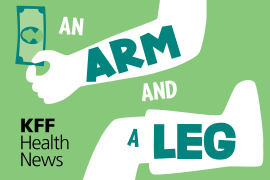Research Roundup: Experimental Drugs; Surgery Checklists; The High Court And Medicaid Rates
Each week, KHN compiles a selection of recently released health policy studies and briefs.
The New England Journal of Medicine:
Practical, Legal, And Ethical Issues In Expanded Access To Investigational Drugs
The expanded-access system [for patients with serious conditions to receive investigational drugs] has become increasingly controversial. Recently, the family of Josh Hardy, a 7-year-old with a life-threatening infection, sought an experimental antiviral drug — brincidofovir — that was recommended by his doctors. ... The question of making untested drugs or vaccines available has also entered public debate in the context of the treatment or prevention of Ebola virus disease .... Each year, thousands of patients wanting to expand their treatment options seek access to incompletely evaluated treatments, but not all obtain them. We discuss the practical, legal, and ethical issues associated with expanded access and use of investigational drugs. (Darrow, Sarpatwari, Avorn and Kesselheim, 1/15)
The New England Journal of Medicine:
Trends In Opioid Analgesic Abuse And Mortality In The United States
An estimated 25 million people initiated nonmedical use of pain relievers between 2002 and 2011. The number of deaths per year attributed to prescription opioid medications reached 16,651 in 2010. In response to the epidemic, hundreds of local, regional, state, and federal interventions have been implemented. ... We used the Researched Abuse, Diversion, and Addiction-Related Surveillance (RADARS) System to describe the diversion and abuse of prescription opioid analgesics .... Our results show a parallel relationship between the availability of prescription opioid analgesics through legitimate pharmacy channels and the diversion and abuse of these drugs and associated adverse outcomes. (Dart et al., 1/15)
American Journal of Managed Care:
Health Information Exchange And The Frequency Of Repeat Medical Imaging
Medical imaging, which is expensive, is frequently repeated for the same patient within a relatively short period of time due to lack of access to previous images. Health information exchange (HIE) may reduce repeat imaging by facilitating provider access to prior images and reports. We sought to determine the effect of an HIE system on the occurrence of repeat imaging. ... We conducted a cohort study of adult patients who consented to participate in a community-based HIE system in an 11-county region in New York. ... Overall, 7.7% of images were repeated within 90 days. If the HIE system was accessed within the 90 days following an initial imaging procedure, imaging was significantly less likely to be repeated (5% repeated with HIE access vs 8% repeated without HIE access. (Vest et al., 1/14)
JAMA Surgery:
A Checklist-Based Intervention To Improve Surgical Outcomes In Michigan
There is widespread enthusiasm for the use of checklists to improve hospital outcomes. Perhaps one of the most widely known and successful examples is the Keystone ICU (Intensive Care Unit) Patient Safety Program. ... In this study, we performed a controlled evaluation of a checklist-based quality improvement intervention—Keystone Surgery—that focused on reducing surgical site infections. We were unable to find a significant association between program implementation and adjusted rates of superficial surgical site infection, wound complication, any complication, and 30-day mortality in patients undergoing general surgery in participating hospitals. This finding was robust across multiple analyse. (Reames, Krell, Campbell and Dimick, 1/14)
JAMA Psychiatry:
Changes In Drug Coverage Generosity And Untreated Serious Mental Illness
More than 1 in 5 disabled people with dual Medicare-Medicaid enrollment have schizophrenia or a bipolar disorder (ie, a serious mental illness). The effect of their transition from Medicaid drug coverage, which varies in generosity across states, to the Medicare Part D drug benefit is unknown. Many thousands make this transition annually. ... we estimated changes in medication use before and after transitioning to Part D, comparing states that capped monthly prescription fills with states with no prescription limits. ... Transition to Part D in states with strict drug benefit limits may reduce rates of untreated illness among patients with bipolar disorders, who have high levels of overall medication use. Access to antipsychotic treatment may decrease after Part D for patients with a serious mental illness living in states with relatively generous uncapped Medicaid coverage. (Madden et al., 1/14)
The New England Journal of Medicine:
Medicare At 50 — Origins And Evolution
Many Americans have never known a world without Medicare. For 50 years, it has been a reliable guarantor of the health and welfare of older and disabled Americans by paying their medical bills, ensuring their access to needed health care services, and protecting them from potentially crushing health expenses. However, as popular as Medicare has become, Congress created the program only after a long and deeply ideological struggle that still reverberates in continuing debates about its future. ... As we mark the beginning of Medicare's 50th anniversary year, this first report in a two-part series recounts the history of this remarkable health care initiative. (Blumenthal, Davis and Guterman, 1/15)
Health Affairs:
Medicare Per Capita Spending By Age And Service: New Data Highlights Oldest Beneficiaries
Medicare per capita spending for beneficiaries with traditional Medicare over age 65 peaks among beneficiaries in their mid-90s and then declines, and it varies by type of service with advancing age. Between 2000 and 2011 the peak age for Medicare per capita spending increased from 92 to 96. In contrast, among decedents, Medicare per capita spending declines with age. (Neuman, Cubanski and Damico, 1/14)
The Kaiser Family Foundation:
Explaining Armstrong V. Exceptional Child Center: The Supreme Court Considers Private Enforcement Of The Medicaid Act
On January 20, 2015, the United States Supreme Court will hear oral argument in Armstrong v. Exceptional Child Center, a case that has the potential to impact the future ability of private parties to sue states in federal court to enforce the requirements of the Medicaid Act. The case raises the issue of whether Medicaid providers can challenge a state law in federal court on the basis that it violates the federal Medicaid Act and therefore is preempted by the Supremacy Clause of the U.S. Constitution. This issue brief examines the major questions raised by the Armstrong case, explains the parties’ legal arguments, and considers potential effects of a U.S. Supreme Court decision. (Musumeci, 1/14)
Here is a selection of news coverage of other recent research:
Healthday:
Neck Artery Stents May Not Be Worthwhile In 'Real World' Setting
Placing stents in the neck arteries, to prop them open and help prevent strokes, may be too risky for older, sicker patients, a new study suggests. In fact, almost a third of Medicare patients who had stents placed in their neck (carotid) arteries died during an average of two years of follow-up. "Death risks in older Medicare patients who underwent carotid artery stenting was very high," said lead researcher Dr. Soko Setoguchi-Iwata, an assistant professor of medicine at Harvard Medical School in Boston. Placing a stent in a carotid artery is a way to prevent strokes caused by the narrowing of the artery. A stent is a tiny mesh tube that is placed into an artery to keep blood flowing, in this case to the brain. (Reinberg, 1/14)
MedPage Today/HealthLeaders Media:
Patients Clueless About Treatment Risks; Docs Little Help
Patients are dangerously clueless about the true value of many common medical interventions, and physicians aren't doing enough to correct their misunderstandings.
That's according to a first-of-its kind meta-analysis of 36 studies, which ran last month in JAMA Internal Medicine. (Clark, 1/12)
The Detroit Free Press:
Research Looks At Why Oldest Seniors Are Hospitalized
A new look at hospital discharge data of extremely elderly patients — those 85 or older — underscores how many visits might be avoidable. The National Center for Health Statistics looked at 10 years of discharge data ending in 2010. (Erb, 1/14)
Medscape:
Occupationally Acquired HIV: Healthcare Workers' Risk Low
Only a single confirmed case of occupationally acquired HIV infection in a US healthcare worker has been reported to the Centers for Disease Control and Prevention (CDC) since 1999, and fewer than 60 cases have been reported since 1985. The low number of cases may reflect widespread adoption of universal precautions, the development of effective antiviral therapies, and advances in postexposure management, M. Patricia Joyce, MD, from the CDC's Division of HIV/AIDS Prevention, National Center for HIV/AIDS, Viral Hepatitis, STD, and TB Prevention and colleagues report in the January 9 issue of the Morbidity and Mortality Weekly Report. (Phillips, 1/12)
Reuters:
Cancer Survivors Plagued By Lack Of Personal Control
After treatment for cancer, survivors often complain about a loss of personal control, a new study found. ... “Cancer survivors are often caught off guard about the lingering problems once treatment is complete,” said Mary Ann Burg, a medical sociologist and clinical social worker at the University of Central Florida in Orlando. She and her colleagues write in the journal Cancer that in earlier studies, between a fifth and a third of cancer survivors ended up with physical or mental health concerns at least five years after treatment. (Seaman, 1/12)






